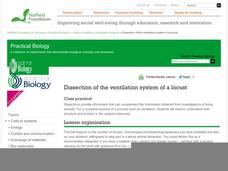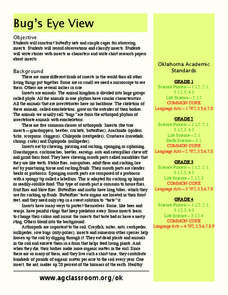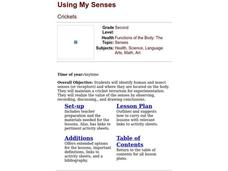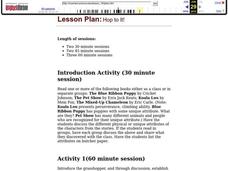Curated OER
Head, Shoulders, Knees & Toes
Students, through observation of crickets, recognize and use proper names for human and insect body parts. They compare and contrast parts of human and insect body parts.
Nuffield Foundation
Dissection of the Ventilation System of a Locust
Jiminy cricket! If you find yourself plagued by fear of dissection, these locust respiratory system dissection directions will walk you through everything you need to know. Teens inspect a living locust to begin with, then jump over to...
Curated OER
Bug's Eye View
Learners explore biology by writing fictitious stories in class. In this insect life activity, students identify many different types of insects in the animal kingdom and the classifications they fall into. Learners collect insects on a...
Curated OER
Adopt-An-Insect Project
Students create a school-wide insect collection investigate the insect world. For this project, each grade level "adopts" specific orders of insects, collect specimens, create classroom collections, and complete related activities.
Curated OER
Hopper Herding
Learners explore biology by examining insects up close. In this grasshopper and cricket lesson, students discuss the types of insects that can jump and why it is important they are able to do so. Learners examine a grassy field with...
Curated OER
Over in the Meadow
Students discover how to locate books on meadow and pond animals and research them. Students discover how to locate fiction/story books about the animals mentioned in the counting book read. Students discover how to locate by author,...
Curated OER
Mini-Ecosystems
Third graders identify the living and non living things in a book read aloud and discuss the interactions represented in the book. Then, they research and include a list of food that each animal needs in an ecosystem. Finally, 3rd...
Curated OER
Grasshopper Plague
Students study grasshoppers and Mormon crickets by visiting website to view images and listen to sound. They research the issue of serious insect infestation. They read about students who eat the insects as snacks and read insect recipes.
Curated OER
Meadow Study
Middle schoolers examine insects they collect in a sweep nets. They identify as many of the insects as they can.
Curated OER
Active Transport in Malpighian Tubules
Young scholars examine the energy dependence of active transport as well as te properties of specificity, competition, saturation, and inhibition. They anesthetize an insect and inject saline into the abdomen.
Curated OER
Using My Senses
Students observe crickets in the terrarium. Have them record in their journal any evidence of crickets having senses. Then they answer questions like these: How do they use their sense organs? Where are they are located?
Curated OER
Using My Senses
Second graders identify human and insect senses and where they are located on the body. They maintain a cricket terrarium for experimentation. They realize the value of the senses by observing, recording, discussing and drawing conclusions.
Curated OER
What Does It Eat?
Pupils use crickets, mealworms, and pill bugs and observe what they choose to eat. In this science lesson plan, students record data, create graphs, and do a write up on what they see happening.
Curated OER
"The Good, The Bad, and The Smelly."
Young scholars explore insects' use of pheromones and beneficial insects versus insect pests.
Curated OER
The Pests of Summer
Students research insects that act as pests during the summer months. They investigate how to protect themselves and their homes from these pests. They study the life cycle of the cicada.
Curated OER
What Does It Eat?
Students, working in research teams, investigate the eating habits of crickets. They collect and record data and compare their methods and results with other groups by making tables or graphs. They sumarize their findings with posters or...
Curated OER
Spy on a Spider
Students view slides or live specimens to name and describe the distinguishing features of groups of arthropods, especially spiders and insects. They complete worksheets, observe webs and then search for and record where spiders can be...
Curated OER
Hop To It!
Students explore grasshoppers. In this grasshoppers lesson, students measure the jumping distance of live grasshoppers. Students then record the jumping distance of people in their group. Students record the distances and students share...
Curated OER
Superstitions
Students discuss the various superstitions they encounter in our culture. Working in groups, they create a vocabulary list of words related to superstitions. Working in teams, they play Pictionary in order to aid in the create of...
Curated OER
Scales, Scutes, and Skins
Students identify the various adaptations of reptiles and amphibians. After distinguishing between reptiles and amphibians, students discuss the ways in which their adaptations aid in their survival. They participate in a hands on...
Curated OER
The City of Ember: chapters 8 and 9
In this comprehension worksheet, students read The City of Ember chapters 8 and 9 and answer multiple choice questions about it. Students complete 13 questions.
Curated OER
A Day in the Life
Students use their research skills to investigate the behavior and characteristics of a rainforest animal. After creating a diary entry, they illustrate the habits and life cycle of the animal. They write the diary entry from the point...
Curated OER
The Great Spider Debate
Students study about the survival and hunting strategies of several different kinds of spiders. They also be introduced to scientific classification of spiders and write a brief report about one of the spider families they observe.
Curated OER
Energy for Animals
First graders discover how animals depend on other animals for energy. They identify sources of energy in their daily life and describes the actions of nightime and daytime animals. They list sources of food and shelter for specific...

























